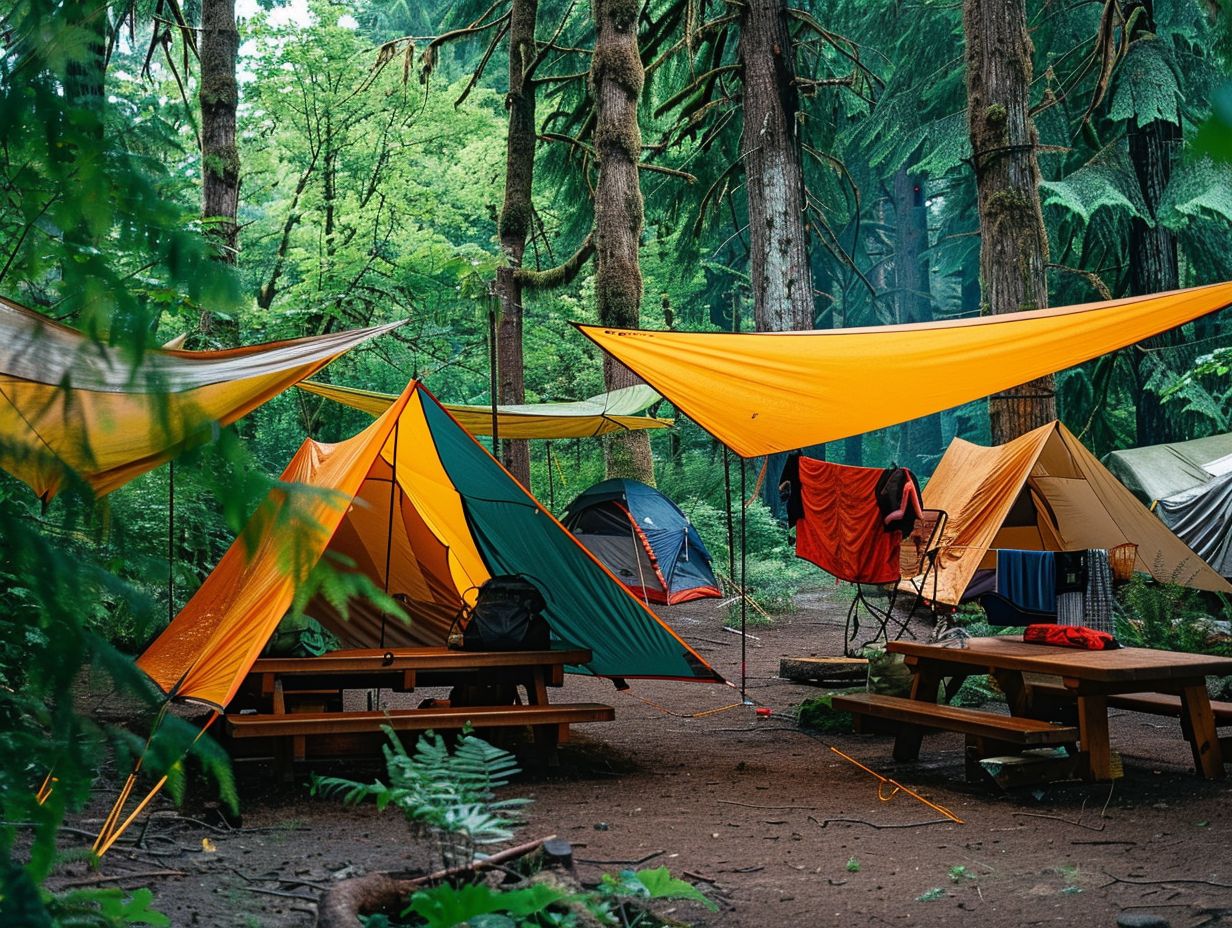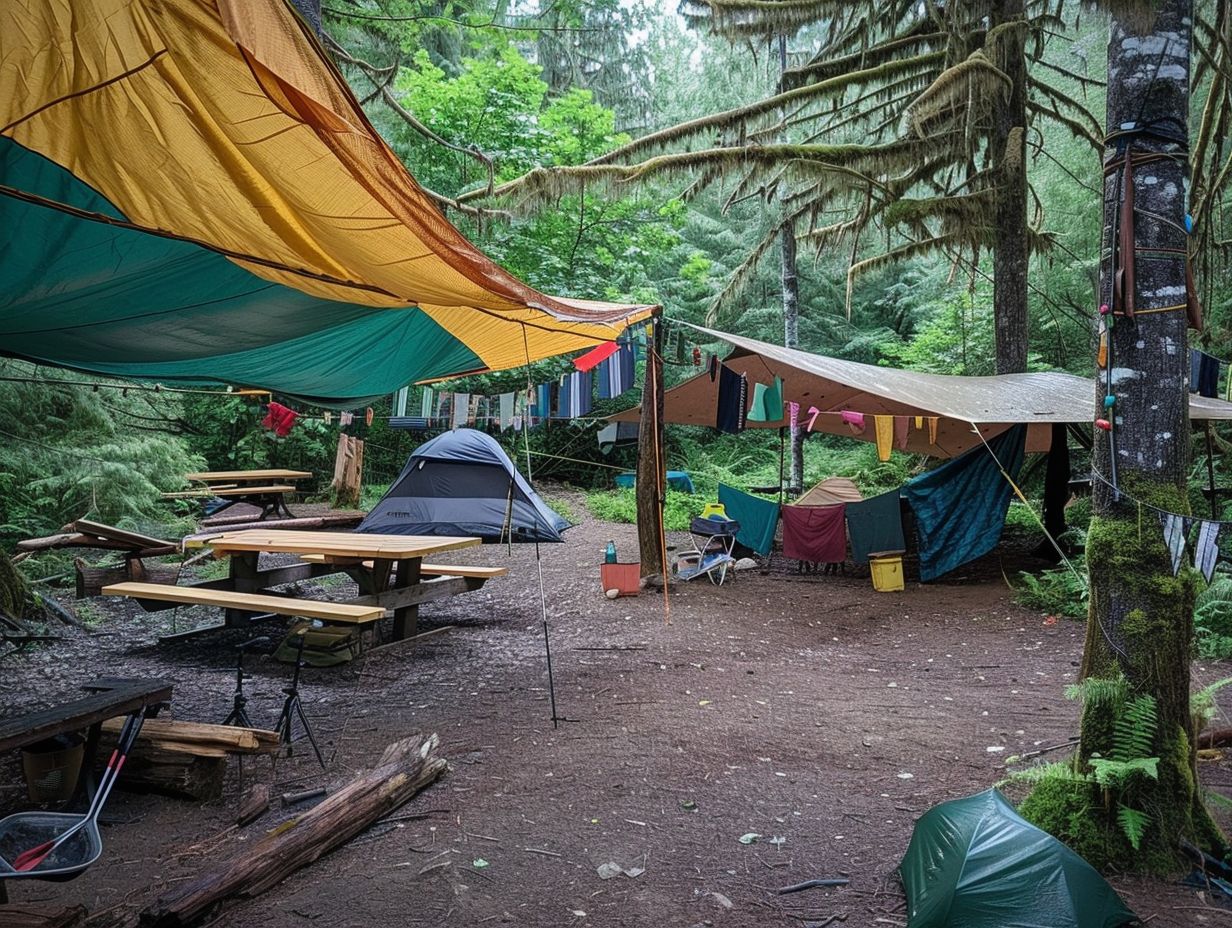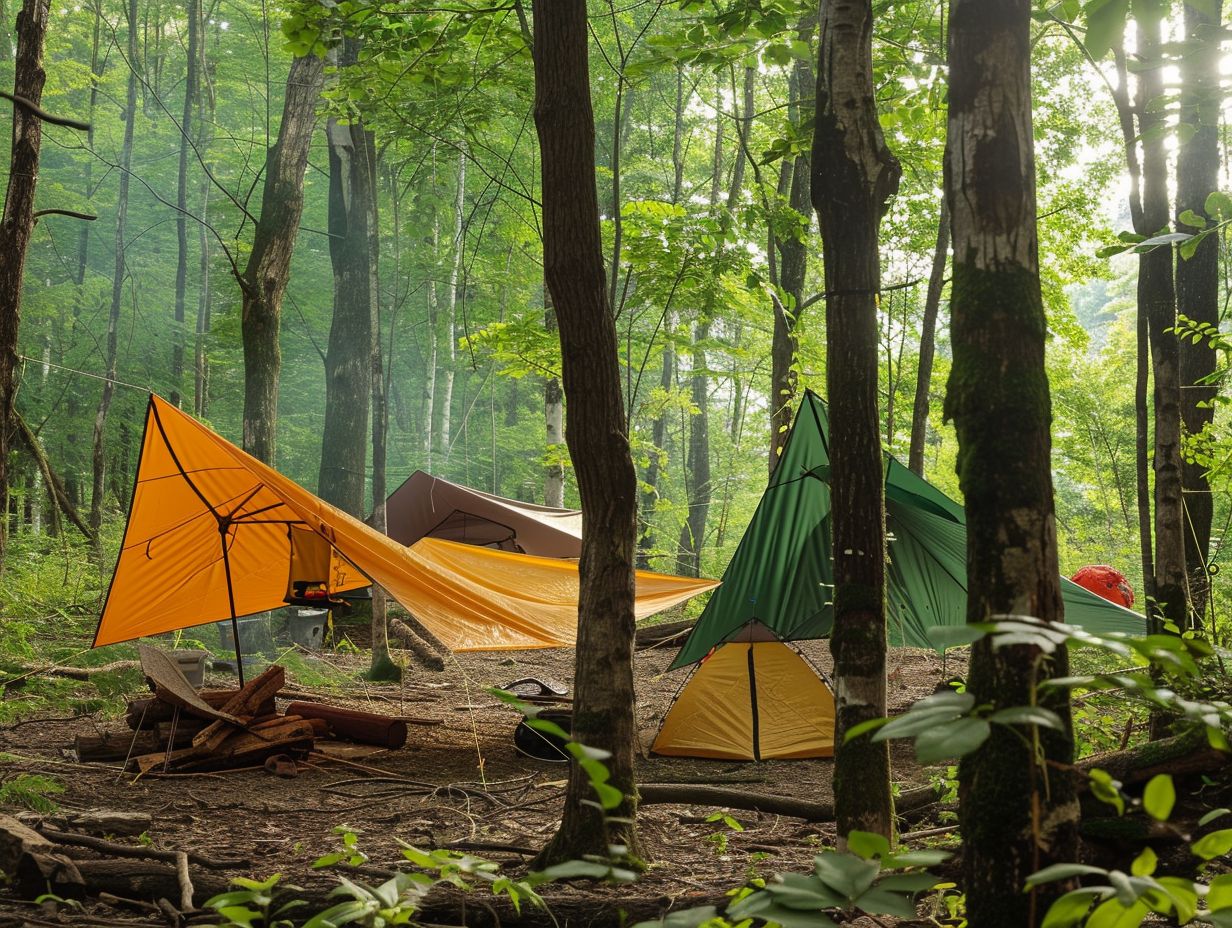If you are seeking to enhance your camping experience, consider utilising the versatile tarp. A tarp can serve multiple purposes while camping, from providing basic shelter to offering sun protection.
This article will delve into the top 15 tarp setups for camping, the essential tools required for tarp setup, the various types of tarps available, methods for securing a tarp in different environments, tips for setting up a tarp in challenging conditions, and repurposing a tarp for additional camping needs.
Explore these insights to elevate your camping adventures.
Key Takeaways:

- The A-Frame shelter is a versatile and easy setup for camping, providing good wind and rain protection.
- Using a tarp as a ground cover can protect your tent and gear from moisture and damage from rough terrain.
- Having a tarp on hand for privacy, emergency situations, and additional camping needs is essential for any camping trip.
1. Basic Tarp Shelter
When setting up a basic tarp shelter in the tundra, it is crucial to use high-quality materials such as the Aqua Quest Safari Tarp and Tyvek for optimal protection against the harsh elements. Follow these steps for a successful setup:
- Select a suitable location that offers natural windbreaks like trees or rocks to enhance protection.
- Lay the tarp flat on the ground and secure the corners with rocks or other heavy items.
- Use durable paracord or guyline to tie down the edges of the tarp, ensuring it is taut to prevent sagging.
- Create a peak in the middle of the tarp to facilitate easy runoff of rain or snow.
In the challenging conditions of the tundra, having a reliable shelter can significantly impact your safety and comfort.
2. Lean-To Shelter
When venturing into the tundra, consider utilising a lean-to shelter constructed from durable Vinyl material, readily available at retailers like Walmart, to offer a dependable and effective camping solution for individuals exploring the outdoors.
The primary benefit of opting for Vinyl material for a lean-to shelter in tundra settings lies in its remarkable resilience to severe weather elements such as strong winds, heavy snowfall, and freezing temperatures. In contrast to conventional materials, Vinyl exhibits high resistance to tearing and delivers superior protection against moisture, establishing it as a durable choice for prolonged outdoor stays.
The accessibility of Vinyl material at stores like Walmart ensures that outdoor enthusiasts have convenient access to the essential supplies required for constructing a robust shelter in isolated tundra landscapes.
3. A-Frame Shelter
Constructing an A-frame shelter using CCS Tundra or Cooke Custom Sewing materials provides you with a durable and stable camping solution, especially in challenging tundra environments. The construction process of an A-frame shelter requires careful assembly of these high-quality materials to guarantee longevity and resilience.
These top-tier materials are renowned for their robustness and ability to withstand severe weather conditions, ensuring a sturdy structure that can endure strong winds and heavy snow loads. The A-frame design boasts exceptional structural integrity, making it a preferred option for outdoor enthusiasts looking for a shelter capable of withstanding the demands of the wilderness.
4. Diamond Shelter
The diamond shelter design, incorporating Kelty Noah tarps fastened with MSR Groundhog Stakes, offers a versatile and efficient solution for camping in the tundra region. Your choice of shelter is crucial when braving the unpredictable conditions of the tundra, and this design has key features that make it a reliable option.
With its unique geometry, this shelter allows wind to flow around the structure smoothly, reducing wind resistance and enhancing stability. This is essential for maintaining safety and comfort in the challenging tundra environment.
The Kelty Noah tarps are renowned for their durability and waterproof properties, ensuring reliable protection against rain and snow. Paired with the MSR Groundhog Stakes, which provide a secure anchoring system even in frozen tundra terrain, this setup offers peace of mind in harsh conditions.
Not only is this shelter design lightweight and compact for easy transport, but it is also highly adaptable to various terrains and weather patterns. These qualities make it a preferred choice for adventurers seeking to explore the demanding landscape of the tundra.
5. Tarp Tent
When you utilise tarp tents with MSR Camring Tensioners and Zing-It lines, you can access a portable and lightweight shelter solution ideal for expeditions in tundra landscapes. The inclusion of MSR Camring Tensioners facilitates quick and effective tension adjustment, ensuring a secure and taut setup even in windy environments.
Coupled with Zing-It lines, these tarp tents gain increased versatility, allowing for various configurations to suit different weather conditions. The lightweight design of these components enables easy transportation in a backpack, adding minimal weight to your overall gear. This arrangement not only provides protection from the elements but also enhances your outdoor experience by creating a cosy and functional camping space.
6. Hammock Shelter
When constructing a hammock shelter using the Ryno Tuff Hammock Rain Fly, which can be purchased at Walmart, you are provided with a comfortable and elevated sleeping solution amidst the challenging conditions of the tundra.
The design of the Ryno Tuff Hammock Rain Fly ensures optimal protection against rain, wind, and snow, ensuring that you remain dry and warm throughout the night. This setup not only raises you above the cold ground but also offers a tranquil and peaceful sleeping environment.
The versatility of this hammock shelter enables you to easily adapt to various terrains and weather conditions, making it a dependable and practical option for outdoor excursions. With its sturdy construction and simple setup process, the Ryno Tuff Hammock Rain Fly is an essential item for any tundra expedition.
7. Tarp as a Ground Cover

Utilising a tarp as ground cover, in conjunction with a PokiPine Travel Outdoor Blanket, provides insulation and protection against the cold and damp conditions commonly found in tundra terrains.
Tarps are renowned for their durability and waterproof properties, serving as a shield between the ground and the individual, effectively preventing moisture and cold from penetrating.
When paired with a PokiPine Travel Outdoor Blanket, not only does it enhance overall comfort, but it also ensures that the body remains warm and dry throughout outdoor excursions.
This combination presents a versatile solution for a range of activities such as camping, picnicking, or leisurely nature outings, elevating the experience while eliminating concerns.
8. Windbreak Shelter
When constructing a windbreak shelter in an exposed tundra environment, consider using a sturdy Kelty Staff Pole, available at Walmart. This pole can help shield your campsite from harsh winds.
To set up the windbreak, begin by firmly securing the Kelty Staff Pole into the ground as the anchor for the shelter. Once the pole is securely in place, attach the shelter material, whether it be a tarp or specialised windbreak fabric, to create a barrier against strong winds.
The height and placement of the pole play a crucial role in maximising the effectiveness of the shelter in diverting wind from your camping area, thereby providing a more comfortable and secure environment for your outdoor activities.
9. Rainfly Shelter
When you’re camping in the tundra, it’s crucial to set up a rainfly shelter using premium Etowah or Paria Sanctuary Siltarp options. These top-notch rainfly shelters are specifically crafted to withstand the harsh weather conditions often encountered in tundra regions.
The waterproof features of Etowah or Paria Sanctuary Siltarps offer a dependable shield against heavy rainfall and snow, ensuring that both campers and their gear remain dry and secure. The robust construction of these shelters guarantees longevity, making them a valuable investment for outdoor enthusiasts venturing into remote tundra landscapes.
By following proper setup and maintenance procedures, these rainfly shelters provide peace of mind and comfort, allowing campers to fully embrace their wilderness adventure.
10. Group Shelter
Utilise the Kelty Noah’s Tarp 9 along with Nite Ize accessories to create a spacious and communal camping arrangement suitable for accommodating multiple individuals in a tundra environment. The extensive coverage provided by the tarp ensures that each member of the group is protected from severe weather conditions such as rain or intense sunlight, enhancing the overall camping experience.
The versatility in setup options and robust materials of the Kelty Noah’s Tarp 9 paired with Nite Ize gear enable adaptable configurations to cater to varying group sizes and preferences.
This setup promotes a sense of unity and encourages collaboration among campers, making it well-suited for group excursions and expeditions in demanding outdoor settings.
11. Tarp for Sun Protection
Using a tarp for sun protection, sourced from Home Depot, can effectively shield you from the intense sunlight and UV exposure commonly found in the tundra landscape.
Employing high-quality tarps not only offers shade but also serves as an additional layer of insulation, aiding in temperature regulation amidst the extreme tundra conditions.
Home Depot provides a selection of durable tarps specifically engineered to endure severe weather elements, guaranteeing both longevity and dependability. These tarps are simple to install and versatile in their uses, rendering them a worthwhile asset for outdoor enthusiasts venturing into the distinctive tundra environment.
12. Tarp for Privacy
Creating a private space with tarps can provide you, as a camper, with seclusion and privacy in the open tundra environment, ultimately enhancing your camping experience by offering a sense of personal retreat.
The versatility of tarps enables you to craft your own secluded nooks, away from prying eyes and distractions. By strategically hanging tarps around your campsite, you can create cosy corners for relaxation or dining, shielded from the elements. These makeshift barriers also assist in defining boundaries, giving you a sense of personal territory in the expansive wilderness.
Tarps can serve multiple purposes, such as acting as windbreaks or rain shelters, ensuring a comfortable and enjoyable outdoor experience for you as a camper seeking solace from the outside world.
13. Tarp for Emergency Situations
In emergency situations, tarps play a crucial role by offering swift and efficient shelter solutions to tackle unforeseen challenges in the ever-changing tundra environment. They can be effortlessly arranged to establish temporary shelters that provide protection against severe weather elements like rain, snow, or strong winds.
Due to their lightweight and portable nature, tarps are well-suited for emergency evacuation circumstances where rapid setup is critical. Their resilience and adaptability render them essential tools for emergency responders, campers, hikers, and individuals residing in disaster-prone regions.
Whether utilised as a makeshift roof, ground covering, or wind barrier, tarps serve as invaluable resources in emergency preparedness.
14. Tarp for Cooking and Dining Area

Utilise tarps to create functional outdoor kitchens, allowing you to prepare meals and dine comfortably amidst the tundra wilderness. The versatility of these tarps serves as reliable barriers against the unpredictable weather conditions often present in the tundra environment.
By establishing designated cooking and dining areas with these tarps, you can protect yourself from elements like wind, rain, or excessive sunlight, ensuring an enjoyable dining experience. Additionally, these makeshift shelters provide privacy and organisation to your campsite, facilitating the storage of cooking equipment and supplies.
The simplicity and flexibility of using tarps enhance the overall convenience of camping in remote locations such as the tundra.
15. Tarp for Gear Storage
Tarps can be a valuable tool for you when it comes to efficiently storing your camping gear and protecting it in the challenging tundra environment. Their flexibility in providing additional shelter and creating makeshift storage areas helps you keep your valuable equipment safe and easily accessible.
By strategically securing tarps, you can protect your gear from adverse weather conditions like snow, wind, and rain, ensuring that essential items such as food supplies, clothing, and tools remain dry and secure.
Tarps can also be used to cover equipment during breaks or overnight stays, providing a quick and practical solution to safeguard your camping gear in the unpredictable tundra terrain.
What Are the Essential Tools Needed for Tarp Setup?
For a successful tarp setup, you will need essential tools and equipment such as pegs, ropes, and tensioners to effectively anchor the tarp and establish a sturdy shelter in the tundra. Pegs play a critical role in securing the tarp firmly to the ground, preventing it from being lifted by strong winds.
Ropes are utilised to offer additional support and structure, establishing a framework for the tarp to be draped over. Tensioners are essential for adjusting the tightness of the tarp, ensuring it is properly stretched out and resistant to sagging.
Additional useful accessories may include a mallet for driving in pegs, a tarp repair kit for addressing any unexpected tears, and carabiners for versatile attachments.
What Are the Different Types of Tarps Available?
Tarps are available in various types such as Tyvek, Vinyl, and Dyneema, each with distinct features and benefits tailored to different camping requirements and environments. Tyvek tarps are renowned for their lightweight and breathable properties, making them well-suited for backpackers and hikers seeking to reduce weight without compromising durability.
On the other hand, Vinyl tarps are heavy-duty and waterproof, making them ideal for camping in rainy or snowy conditions where protection from the elements is essential. Dyneema tarps, on the other hand, are extremely strong and tear-resistant, making them suitable for rugged outdoor adventures where durability and reliability are crucial.
Each type of tarp offers campers a unique set of characteristics to ensure a comfortable and secure outdoor experience.
How Can a Tarp Be Secured in Different Environments?
When securing a tarp in various environments, the use of methods such as MSR Groundhog Stakes and MSR Camring Tensioners is crucial for effectively anchoring the tarp and ensuring its ability to withstand diverse conditions.
MSR Groundhog Stakes are specifically crafted with a durable Y-beam shape and are lightweight, making them highly effective for securing tarps in soft ground or snowy terrain. These stakes are renowned for their exceptional holding power, even in loose soil.
Conversely, MSR Camring Tensioners offer a versatile solution for adjusting tension in the tarp lines. Their user-friendly design enables swift and accurate tightening or loosening, guaranteeing stability in fluctuating weather conditions.
By strategically combining these tools, a dependable tarp shelter can be constructed that can adapt to its surroundings and provide protection against the elements.
What Are Some Tips for Setting Up a Tarp in Challenging Conditions?
When setting up a tarp in challenging conditions, strategic placement, proper tensioning, and the use of Zing-It lines are essential for creating a reliable shelter in adverse tundra settings.
A key consideration for positioning the tarp effectively is to take into account the direction of the wind. Placing the tarp at right angles to the wind can help minimise flapping and ensure optimal coverage.
When tensioning the tarp, it is important to pull the corners tight while allowing some flexibility to accommodate changes in weather conditions. Zing-It lines are a valuable resource for reinforcement, as they are lightweight yet extremely strong, offering the additional support necessary in windy or stormy environments.
How Can a Tarp Be Repurposed for Other Camping Needs?
Tarps provide versatility in camping by being adaptable for various outdoor needs. They can be repurposed as makeshift rainfly shelters, ground covers, or even improvised backpack covers, showcasing their ability to meet different requirements.
Additionally, these durable sheets of material can function as windbreaks to protect a campsite from strong gusts, or as privacy screens to establish secluded areas within the wilderness.
Tarps can be creatively utilised as water collection systems during rainfall or as impromptu seating areas around the campfire. Their lightweight design facilitates easy packing and carrying, making them an essential multifunctional tool for any camping expedition.
Frequently Asked Questions

What are the benefits of using the best tarp setups for camping?
The best tarp setups for camping provide a variety of benefits, such as protection from rain and sun, added privacy, and increased versatility in setting up a campsite. They can also be used as a ground cover or shelter for cooking or relaxing.
What factors should I consider when choosing the best tarp setup for my camping trip?
When choosing the best tarp setup for camping, consider the size and shape of the tarp, its waterproof and UV protection capabilities, as well as its weight and packability for easy transportation. You should also think about the type of camping you will be doing and the terrain you will be camping on.
What are some popular tarp setups for camping?
Some popular tarp setups for camping include the A-frame, lean-to, and diamond tarp configurations. Each offers different levels of coverage and protection, so it’s important to choose the setup that best fits your needs and the environment you will be camping in.
Can I use a tarp setup for camping in all types of weather?
While tarp setups provide great protection from rain and sun, they may not be suitable for extreme weather conditions such as heavy winds or snow. It’s important to check the weather forecast and choose a tarp setup that can withstand the expected weather conditions.
What materials are the best for tarp setups for camping?
The best materials for tarp setups for camping are durable, waterproof, and lightweight. Common materials include nylon, polyester, and polyethylene. It’s also important to consider the thickness and denier of the material for added strength and durability.
Are there any additional tips for setting up the best tarp setup for camping?
Yes, here are a few additional tips:
- Always carry extra stakes and guy lines for securing your tarp setup.
- Consider using a footprint or ground cloth under your tarp to protect it from sharp objects and prolong its lifespan.
- Practice setting up your tarp before your camping trip to ensure a smooth and efficient setup at the campsite.
- Make sure to properly anchor your tarp to prevent it from flapping and making noise in the wind.



